Mock Test Mistakes to Avoid: Top 10 Errors CAT Aspirants Keep Repeating

Mock Test Mistakes to Avoid: Top 10 Errors CAT Aspirants Keep Repeating For most CAT aspirants, mock tests are the real battlefield where strategy is forged, stamina is tested, and nerves are trained. But here’s the brutal truth: many students keep making the same avoidable mistakes in mocks, which leads to stagnant scores and frustration. Whether you’re just starting your mock journey or deep into the testing season, this post breaks down the top 10 mistakes aspirants make in mocks — and what to do instead. 🚫 Mistake #1: Taking Mocks Without an Objective Most students take mocks just to “see where they stand” — but that’s not enough. Without a clear focus, your mock becomes a shot in the dark. ✅ What to Do: Set a specific goal for each mock — e.g., “I will improve my speed in DILR,” or “I will not panic if I don’t know the first 5 questions.” Use mocks to test strategies, not just performance. 🕐 Mistake #2: Mismanaging Time Across Sections One of the most common mistakes is either overspending time on one section (especially Quant) or panicking midway and rushing through. ✅ What to Do: Stick to the section time limits — CAT has fixed sectional timing (40 minutes per section). Practice time-boxing within sections — allocate rough minutes to questions or sets. ❌ Mistake #3: Starting with the First Question Starting with Q1 may not always be the best strategy. CAT doesn’t reward sequential solving — it rewards smart selection. ✅ What to Do: Spend the first 2–3 minutes scanning the section. Attempt your strength areas first — build early confidence. 📉 Mistake #4: Not Analyzing Mocks Thoroughly Many students give the mock, check the percentile, maybe glance at wrong answers, and move on. Big mistake. ✅ What to Do: Spend 2x more time analyzing than taking the mock. Categorize every question as: Correct and fast ✅⏱️ Correct but slow ✅🐢 Incorrect due to concept ❌📚 Incorrect due to silly mistake ❌😓 Not attempted 🚫 🔁 Mistake #5: Changing Strategies Too Frequently After every low score, many aspirants change their approach drastically — new order of attempt, new section strategy, etc. ✅ What to Do: Allow at least 3 mocks to test any new strategy. Track progress over a rolling average — not just one-off spikes or drops. 💀 Mistake #6: Panicking Mid-Test If one section goes badly, students often carry that anxiety into the next one, ruining overall performance. ✅ What to Do: Practice mental resets between sections — deep breath, neck stretch, sip water. Train in mock-like environments: 2-hour uninterrupted practice, ideally at the same time as the actual exam slot. ⚠️ Mistake #7: Ignoring Easy Questions Often students miss out on easy questions while getting stuck on mid-to-hard ones, especially in DILR or QA. ✅ What to Do: Train your eye to quickly spot sitters. If a question feels “doable but long,” skip and return later — don’t bleed time early. 📵 Mistake #8: Practicing Only Online But Taking Notes Offline (or vice versa) Mismatch in test practice environment can distort your test-day experience. ✅ What to Do: Simulate the exact CAT environment: Use same device (laptop > mobile). Keep rough sheets and pen ready. Sit in a quiet, distraction-free space. 📊 Mistake #9: Obsessing Over Percentile, Not Learning Focusing only on percentile (especially in early mocks) creates unnecessary pressure and prevents real learning. ✅ What to Do: Use initial mocks to build your test temperament. Track accuracy %, attempts, and sectional balance more than overall percentile initially. 🧩 Mistake #10: Ignoring Sectional Balance Many aspirants focus only on their strong sections and delay fixing the weak ones — this causes disaster in actual CAT, where each section has a minimum cutoff. ✅ What to Do: Alternate mocks with sectional tests. For every full mock, have 2–3 focused sectional drills. Build minimum attempt and accuracy thresholds for weak sections. 🛠 How to Build an Effective Mock Test Strategy Start with 1 mock/week, and increase frequency after 2 months of base prep. Maintain a mock diary – for every mock, record: Scores by section Top 3 mistakes 1 learning to apply next time Revise weak concepts weekly based on mock analysis. Do a post-mock analysis group session (if possible) with peers or mentors. 🧠 Final Thoughts: Mock Tests Are Not Just Tests – They’re Training Grounds Mocks are not about “predicting” your CAT score. They’re about building the rhythm, mental agility, and calm decision-making that CAT demands. The real differentiator is not how many mocks you give — it’s how you analyze, adapt, and evolve with each one. 📥 Want a FREE Mock and expert feedback Drop your email [here] or take a free mock and feedback on your performace with a mentor at Endeavor Magic to get started and be eligible for attractive scholarship on Endeavor Magic Pro and test series.
The MBA Rush

The MBA Rush Over the last two decades, India’s MBA landscape has undergone a dramatic transformation. Once the aspiration of a select few, the MBA has now become a mainstream career accelerator for thousands of students and professionals across the country. As we approach the 2025–26 admission cycle, several indicators suggest we are on the brink of one of the most competitive MBA seasons in recent memory. Rising Aspirations: A Statistical Snapshot Let’s begin with some numbers. In 2001, close to 150,000 aspirants appeared for the Common Admission Test (CAT). By 2024, over 329,000 students registered for CAT, with nearly 293,000 appearing for the exam. Interestingly, between 2014 and 2020, CAT registration numbers plateaued around the 2.1 to 2.4 lakh mark. However, a renewed spike has been observed since 2021, with a sharp jump of nearly 70,000 takers between 2022 and 2024 alone. This is the first time in almost a decade that the numbers have moved so decisively upward, indicating a renewed trust in management education as a reliable career path. Looking ahead, many experts believe CAT 2025 could break the 350,000 registration mark, driven by increased demand, media focus, and widespread career uncertainty in technology, startups, and global education avenues. What’s Behind the Rise? Three interconnected trends: A sharp rise in the number of MBA institutes and seats: From a few hundred institutes in the early 2000s, India now has over 3,500 B-schools, with states like Karnataka alone offering 33,800+ seats. A proven Return on Investment (ROI): Top institutes like FMS Delhi, with fees under INR 2 lakh, offer packages of INR 30+ LPA. Even newer IIMs are delivering average placements in the INR 16–20 LPA range. Wider access and inclusion: The intake of women at IIMs has grown from 90 in the early 2000s to over 700 today. Institutes like IIM Visakhapatnam now have 51% women in their cohorts. How 2025–26 looks Different The MBA surge in 2025–26 is not just about the numbers. It’s about the changing context: Tech Sector Slowdown: With layoffs, hiring freezes, and flattening career paths in IT and startups, many engineers and tech professionals are looking to pivot toward management roles. Tightened Foreign Visa Opportunities: With increasing restrictions on H1B visas and stricter immigration policies in the US and UK, many students who once preferred MS or global MBAs are now choosing top Indian B-schools as safer, ROI-driven alternatives. Expanded IIM Capacity: Even with more IIMs and greater seats, the demand-supply gap for top-tier management education remains high, keeping the stakes intense. ROI: Still the Strongest Hook For many aspirants, the real question is: Is an MBA still worth it? The data answers with a resounding yes. IIM Ahmedabad, Bangalore, Calcutta: Fees ~INR 25–28 lakhs | Avg Package: INR 30–36 LPA IIM Ranchi/Nagpur: Avg CTCs have seen 30%+ YoY growth; highest offers touch INR 50–70 LPA. FMS Delhi: With ultra-low fees and top-tier placements, it remains the gold standard in ROI. Online/Executive MBAs: Even affordable options (INR 2–3 lakh) show ROIs exceeding 500–700% over 5 years for professionals switching industries or moving into leadership roles. The Shifting Profile of MBA Aspirants 2025–26 will likely mark a further diversification of the MBA applicant pool: More professionals with 3–5 years’ experience seeking career resets. Higher women participation due to inclusive policies and mentorship. Entrepreneurs & re-skillers exploring MBAs to professionalize or pivot. STEM graduates moving away from saturated tech roles. Advice to 2025 Aspirants: Compete Smart Don’t follow the herd. Choose institutes with a strong ROI track record and brand value both. It is not a trade off but combination of two which will give you rewards in long run. Specialize early. Analytics, product management, finance, and marketing all have different career trajectories. Widen your net. Consider new IIMs, private B-schools, and hybrid online programs if your profile fits. Build your narrative. Admission is not just about scores. Profile building, internships, social work, and achievements matter more than ever. Final Thoughts India’s MBA ecosystem is more vibrant than ever, but also more competitive. As the tech sector recalibrates and global opportunities remain uncertain, the MBA offers a powerful way to future-proof your career. The nature of exams be it CAT or other major entrance exams stresses on logical thinking and reasoning making it a leveller for all whether someone has aced academics so far or not.
🎯 CAT 2025 Official Notification is Out! Here’s Everything You Need to Know
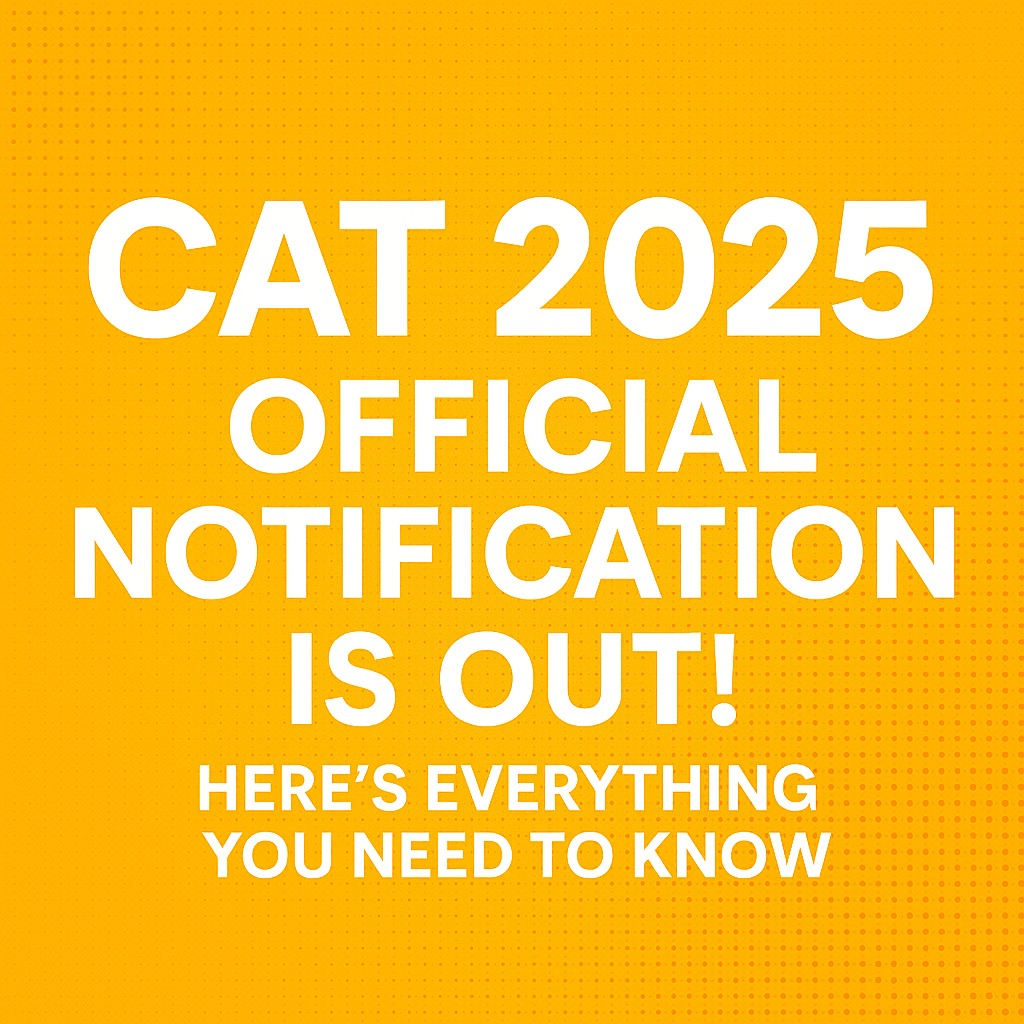
MBA colleges. The much-anticipated Common Admission Test (CAT) 2025 notification is finally here! Released by IIM Kozhikode on July 27, this announcement kickstarts the journey for lakhs of MBA aspirants across India. Whether you’re a final-year undergraduate student or a working professional aiming for top B-schools like the IIMs, FMS, SPJIMR, or MDI—this is your moment. 📌 CAT 2025 Quick Snapshot Exam Conducting Body: IIM Kozhikode Official Website: www.iimcat.ac.in 🗓️ CAT 2025 Important Dates Event Date Notification Release July 27, 2025 Registration Begins August 1, 2025 (10:00 AM IST) Registration Closes September 13, 2025 (5:00 PM IST) Admit Card Release November 5, 2025 CAT 2025 Exam Date November 30, 2025 (Sunday) Result Declaration First week of January 2026 (Tentative) ✅ Who Can Apply? A Bachelor’s degree with at least 50% marks (45% for SC/ST/PwD). Final-year undergraduate students are also eligible to apply. 💰 CAT 2025 Application Fee Category Fee General/EWS/OBC ₹2,600 SC/ST/PwD ₹1,300 🧠 CAT 2025 Exam Pattern Mode: Computer-Based Test (CBT) Duration: 120 minutes (2 hours) Sections & Timing: Section Time Allotted Verbal Ability & Reading Comprehension (VARC) 40 mins Data Interpretation & Logical Reasoning (DILR) 40 mins Quantitative Ability (QA) 40 mins Total Questions: ~68 Marking Scheme: +3 for correct answers –1 for incorrect MCQs 0 for TITA (non-MCQs) 🚀 How to move forward? ✅ Create a Study Plan Prioritize weak areas and set weekly goals. ✅ Take Mock Tests Start with sectional tests, then shift to full-length mocks. www.endeavormagic.com ✅ Analyze & Improve Post-test analysis is the secret sauce of toppers. ✅ Stay Updated Visit the official website regularly. All the best for CAT 2025
Top 21 Non-IIM 2-year MBA/PGDM Colleges in India (2024–25)
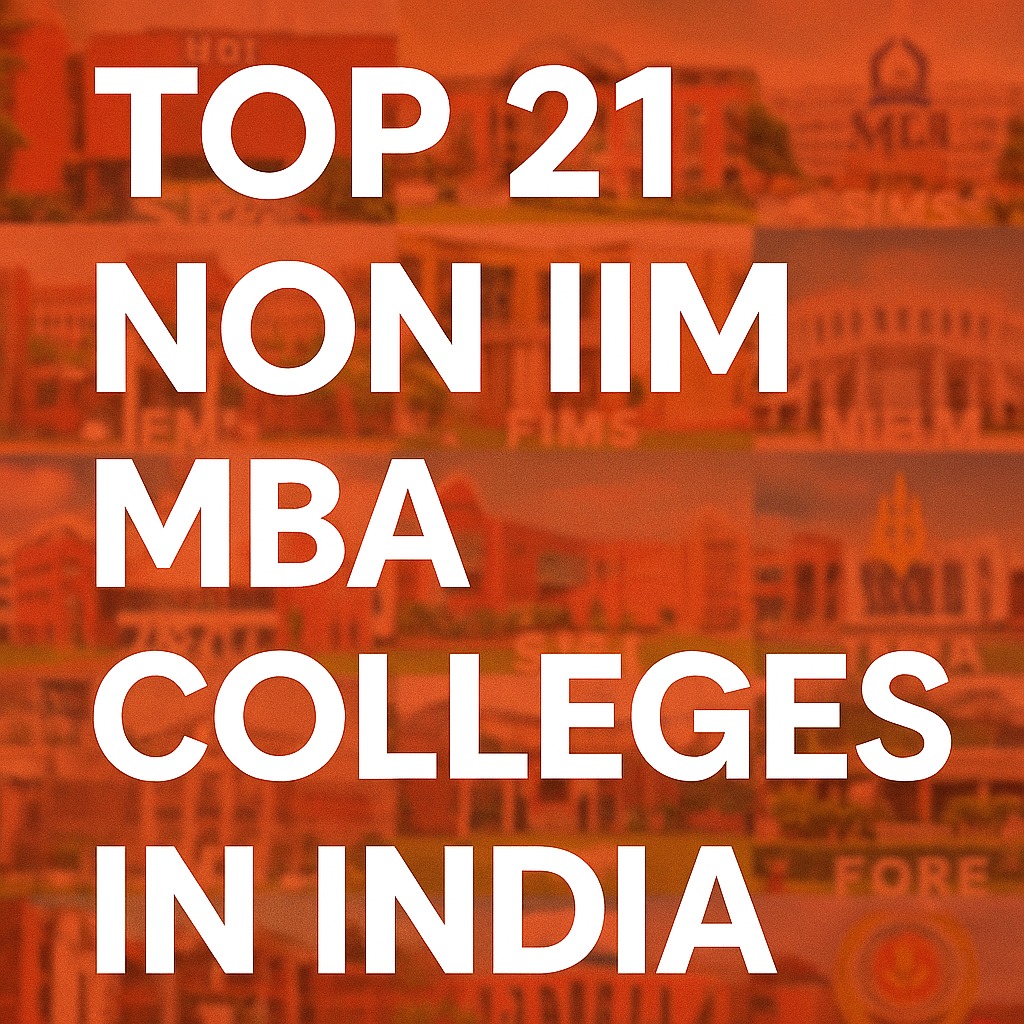
Top 21 Non-IIM 2-year MBA/PGDM Colleges in India (2024–25) The following report reviews the key features of the top 25 non-IIM business schools (2‑year full-time MBA/PGDM) in India. For each institute we summarize program highlights, reputation, alumni, fees, placements, recruiters, entrance exams, ROI, campus life, global links, and career prospects. A comparison table at the end highlights key metrics (entrance exam, fees, average salary, etc.). This data is collected from online sources and it is recommended students check official websites for latest verified data. XLRI Jamshedpur (Xavier School of Management) Programs & Curriculum: Two-year full-time PGDM programs in Business Management and Human Resource Management. XLRI’s curriculum is known for its rigorous core subjects and diverse electives (finance, marketing, operations, etc.) plus strong ethics and leadership emphasis. Reputation & Infrastructure: One of India’s oldest top B-schools; consistently ranked among the best (NIRF 2024: Rank #9). The lush residential campus (Jamshedpur) includes extensive libraries, case-rooms, sports facilities and technology labs. Alumni & Legacy: XLRI has a powerful alumni network in industry and HR. Notable alumni include Leena Nair (Chief HR Officer, Unilever) and Sandeep Bakshi (CEO, ICICI Prudential), Rakesh Kapoor (ex-CEO, Reckitt Benckiser) etc. This legacy of leaders reflects its long-standing brand. Fees: Total tuition ~₹28.6 lakh for the 2‑year flagship PGDM program (2024‑26). (Approx. ₹14.3L/year, excluding living expenses.) Placements (2024): Median salary ₹29.0 LPA; highest international ₹110 LPA (₹1.1 Cr) and domestic ₹75 LPA. (Top 10% average ~₹52.0 LPA, top 25% ~₹44.3 LPA.) Leading recruiters include major consulting firms, banks and MNCs. For example, Consulting (26% of roles) – McKinsey, BCG, Bain, Accenture Strategy; BFSI (22%) – Goldman Sachs, Citibank, Axis Bank; Sales/Marketing (18%) – HUL, ITC, Nestlé, P&G, Samsung Entrance Exam & Cutoff: XLRI uses the XAT. Typical cutoffs are very high (around 30–32 marks, ~95+ percentile). Outstanding XAT performance (95–99 percentile) is generally required for shortlisting. ROI: Given the high placement packages, ROI is among the best. With fees ~₹14.3L/year and average salaries around ₹30L, many students recoup costs within a year and see strong medium/long-term returns. Campus Culture & Student Life: The fully residential campus fosters an intense but balanced life – strong student clubs (cultural, entrepreneurship, social outreach), sports, and the big “Malhar” cultural fest. Emphasis on “Xavier values” (ethics, service) shapes a close-knit, socially conscious student community. Global Linkages: XLRI has collaborations and student exchange programs with premier global schools. It “has developed academic collaborations and exchange partnerships with prestigious institutes throughout the world”, exposing students to international electives and summer projects. Career Prospects: Graduates enter high-demand sectors (strategy/consulting, finance, tech, FMCG, HR, NGOs) and often advance quickly. Early career surveys show many in leadership or specialist roles; long-term prospects are very strong due to the institute’s brand and network. FMS Delhi (Faculty of Management Studies, DU) Programs & Curriculum: Two-year full-time MBA (University of Delhi). Focus is on core management functions (finance, marketing, HR, operations) with a reputation for finance and marketing rigor. Unique feature: very low-cost MBA (DU department). Reputation & Infrastructure: Consistently among India’s elite B-schools. Though not in NIRF “Management” category (as part of DU), FMS is often ranked alongside top IIMs in media. It is known as the “Oxbridge of India” (affiliated with DU). The campus is located in Delhi University’s North Campus, with lecture halls and proximity to academic resources of DU (libraries, sports, etc.). Alumni & Legacy: Strong alumni in banking and industry. Notables include Romesh Sobti (former CEO, IndusInd Bank) and Neelam Dhawan (former MD, Microsoft India). FMS alumni network is influential in BFSI and consulting. Fees: Extremely low: total ₹2.29 lakh for two years (₹1.15L/year). (Hostel/food, if any, extra but overall student costs are negligible.) Placements (2024): Highest ₹123 LPA; median ₹31.0 LPA; average ~₹34.1 LPA. (For reference, in 2023 batch the average was ₹34.1L, median ₹31L.) Nearly 100% placement. Top roles (and recruiters) span BFSI (27%), marketing (20%), IT/analytics (18%), BFSI/healthcare, etc. Recruiters include Accenture, Adani, Airtel, Amazon, Capgemini, Deloitte, KPMG, Bain, Ola, Wipro, Microsoft, EY, etc.. Entrance Exam: CAT is required. Typical shortlisting cutoff is extremely high (≈99+ percentile); diversity is encouraged via relaxation for female candidates (+5 marks). ROI: The ROI is unparalleled – tuition is only ~2.3L total and average salary ~₹34L. Even entry-level salary fully covers fees in one year, yielding an ROI >1000%. Campus Culture: FMS is small but intense. Students (mostly commuters in Delhi) form tight study networks and active clubs (finance, consulting, sports). Being part of DU’s vibrant campus, there are numerous cultural and technical fests (e.g., Rendezvous), but the B-school itself has no separate campus. Global Linkages: Exchange programs exist through DU’s international MOUs. FMS students occasionally go for short-term exchange with partner universities (subject to DU exchange slots). Career Prospects: FMS graduates are highly sought after in banking, consulting, finance, tech, and government. Given their cost-effectiveness, many FMS alumni rapidly rise to senior roles; several become CFOs or MDs in companies (reflecting the alumni noted above). SPJIMR Mumbai (S.P. Jain Institute of Management & Research) Programs & Curriculum: Two-year PGDM (Business Management) with options for industry-focused electives (Healthcare, Energy, etc.). The pedagogy stresses “Give India” (social sector), Design Thinking, and Global Immersion Programs. Reputation & Infrastructure: Top-ranked private B-school (Financial Times #1 in India, #40 globally for masters’ management 2023). NIRF (2024) ranks SPJIMR ~#20. The modern Mumbai campus (Andheri West) has smart classrooms, an innovation lab, and student residences (optional). Alumni & Legacy: Notable alumni include Debjani Ghosh (President, NASSCOM), Girish Wagh (Executive Director, Tata Motors), Mahesh Madhavan (CEO, Bacardi), among others. SPJIMR’s alumni hold senior positions across industry. Fees: ₹22.5 lakh total for the two-year PGDM (Indians). (There are separate fee structures for specialized PGDMs.) Placements (2024): Average ₹33.0 LPA, median ₹31.5 LPA, highest ₹81.0 LPA. (100% of students placed.) Leading sectors: Consulting (35% of batch) – recruiters included Accenture, BCG, Deloitte, Kearney, PwC; and substantial shares in BFSI, FMCG, Pharma, Tech. Indeed, “FMCG, Consulting, BFSI, Pharma and Tech emerge as top recruiting sectors.”. Entrance Exam: SPJIMR accepts CAT/XAT/GMAT/GRE. The CAT/XAT shortlisting cutoff is
MICA – The coveted programmes & All you need to know
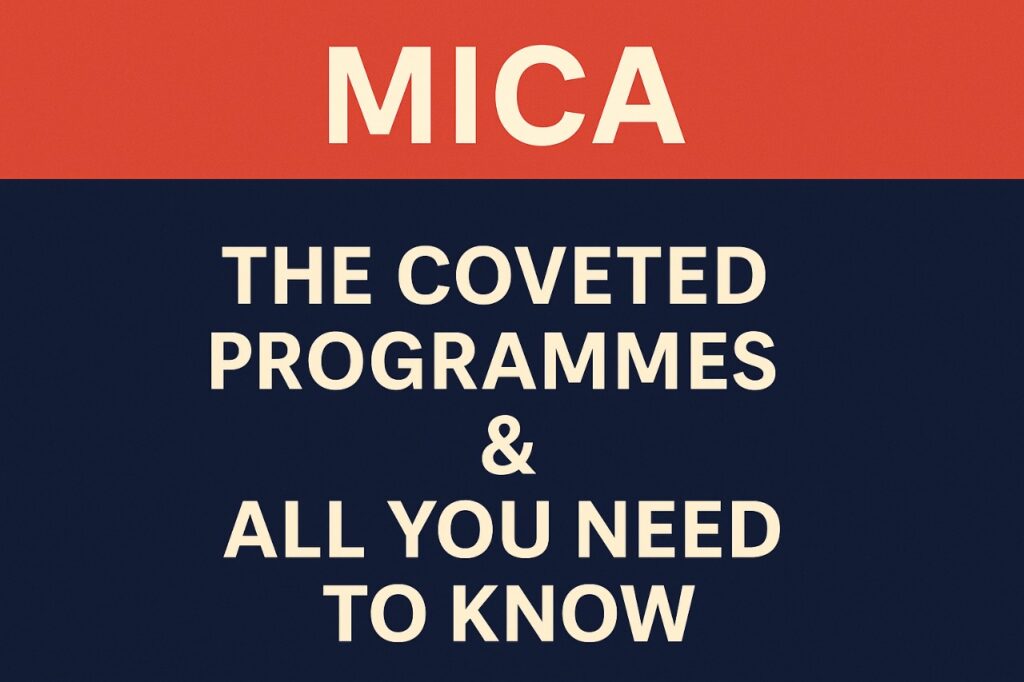
MICA (formerly known as Mudra Institute of Communications, Ahmedabad) stands out as India’s premier B-school for Strategic Marketing and Communication. Established in 1991, MICA has consistently evolved to stay ahead in the rapidly changing domains of marketing, media, digital communication, and branding. As the only residential institute in India dedicated to creating leadership in strategic marketing and communication, MICA blends creativity with business strategy like no other. Legacy and Evolution Founded by the Mudra Foundation, MICA was envisioned as a hub for innovation in communication. Over the years, it has developed into a globally recognized institution, known for its focus on creativity, consumer insight, and digital transformation. With over three decades of experience, MICA has built a strong alumni network, many of whom now lead brand, digital, and media strategy roles across top global firms. MBA Programme Highlights: PGDM-C and PGDM MICA offers two flagship full-time residential programmes: PGDM-C (Post Graduate Diploma in Management – Communications): A unique course that focuses on Strategic Marketing and Communication, combining core management disciplines with insights into media, advertising, and digital marketing. PGDM (General Management): Launched in recent years, this programme retains MICA’s strong foundation in marketing but is structured more broadly for general management aspirants. Both programs are AICTE-approved and span two years. Students can choose from specializations in Brand Management, Media Management, Digital Communication Management, Marketing Analytics, and Advertising. Faculty and Pedagogy MICA boasts a world-class faculty with a rich blend of academic rigor and industry experience. Professors are active in research, consulting, and media discourse, ensuring that classroom discussions are always contemporary. Faculty members bring expertise from IITs, IIMs, global universities, and multinational corporations. Courses are taught using a mix of case studies, live projects, workshops, simulations, and lectures. Batch Profile (2023-2025) MICA values diversity in background, thought, and experience. The batch typically features: Class Size: ~180-200 students per programme Gender Diversity: ~55% female, 45% male Educational Background: Mix of engineers, commerce, arts, media, and management graduates Work Experience: 50-60% freshers, rest with work experience across sectors like IT, media, startups, consulting, and FMCG This blend fosters peer learning and an inclusive culture of innovation. Placements and Career Opportunities MICA enjoys robust placements driven by its niche positioning in marketing and communication. Key highlights from the latest placement season: Average CTC: ~INR 20.1 LPA Highest CTC: INR 36+ LPA Top Recruiters: Google, Amazon, Reckitt, Tata Digital, L’Oréal, P&G, Accenture, GroupM, Flipkart, Deloitte, HUL, and more Roles Offered: Brand Manager, Digital Marketing Manager, Media Strategist, Product Manager, Consumer Insights Analyst, Marketing Analyst, Content Strategist The alumni network actively supports placement, mentoring, and career growth. Admission Process and Safe Scores Admissions to MICA’s PGDM and PGDM-C are via MICAT, which is a two-part admission process: Eligibility: Bachelor’s degree in any discipline + a valid score in at least one of the following exams: CAT (Common Admission Test) XAT (Xavier Aptitude Test) GMAT (Graduate Management Admission Test) MICAT: A unique entrance exam that tests: Divergent Thinking and Creativity Written Communication Psychometric Analysis Quantitative & Verbal Skills General Awareness (with focus on media/marketing) Selection Process: Shortlisting based on CAT/XAT/GMAT + MICAT Group Exercise (GE) and Personal Interview (PI) Safe Scores (Indicative, based on past trends): CAT/XAT/GMAT: 85+ percentile MICAT: Scoring 50-60 percentile (scaled) with strong performance in GE-PI gives a solid chance MICA places significant emphasis on creativity and clarity of thought rather than just aptitude scores. Why students pick MICA? Unmatched focus on marketing, branding, and communication Pedagogical innovation and industry-aligned curriculum Global exposure through exchange programs and live projects Strong industry connect and consistently high ROI A vibrant campus culture that nurtures creativity and leadership For students who aspire to lead in the evolving world of marketing and media, MICA offers the perfect launchpad.
The XAT sized Opportunity
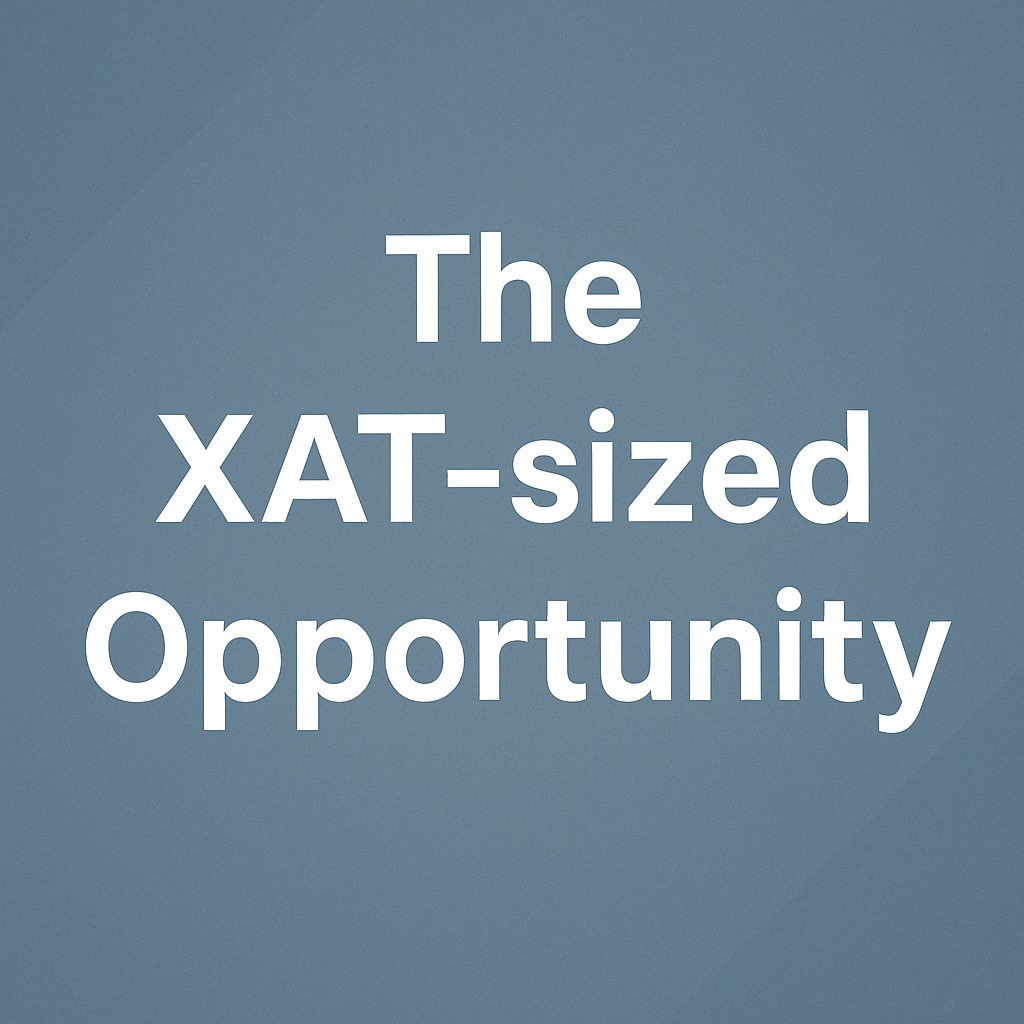
XAT is the second most popular exam after CAT in India purely because it has the highest number of top B-School Seats. Here’s a concise, easy‑to‑grasp rundown of everything from the exam structure to top PGDM/HRM colleges, their seat intakes, fees, and placement highlights to let an aspirant understand why XAT is so big and how to get started. XAT 2026: The Basics When & Who Typically scheduled first Sunday of January each year (so expect early January 2026). Conducted by XLRI – Xavier School of Management, Jamshedpur. Registration Window & Fee Opens mid‑July through early December of the preceding year. Exam fee around ₹ 2,200, with an extra ₹ 200 for each XLRI programme you apply to. Eligibility Any graduate (or final‑year student) from a recognised university (minimum 3‑year degree). No minimum percentage or age limit. Exam Pattern Duration: 180 minutes total Part 1 (170 min): Quantitative Ability & Data Interpretation, Verbal & Logical Ability, Decision Making (approx. 75 questions) Part 2 (10 min): General Knowledge (20 questions; for profile but not counted in percentile) Marking Scheme: +1 for correct, –0.25 for wrong; penalty for excessive unattempted questions. Top PGDM/HRM Colleges Accepting XAT Below is a snapshot of leading institutes that use XAT scores for admissions. For XLRI Jamshedpur, only the two‑year PGDM programmes are listed (Business Management and Human Resource Management). Institute (Campus) Seats Total Fees (₹) Avg. CTC (LPA) Highest CTC (LPA) XLRI Jamshedpur 420 25.8 L 27.07 75 • PGDM – Business Management (BM) 240 (included above) • PGDM – Human Resource Management (HRM) 180 SPJIMR Mumbai (PGDM) 480 23.4 L (est.) ~ 26 ~ 31 XIM Bhubaneswar (MBA‑BM) ~ 350 19.95 L 19.53 30 MICA Ahmedabad (PGDM‑C) 240 21 L 19.21 35.5 TAPMI Manipal (PGDM) 630 17.10 L 13.84 32.02 IBS Hyderabad (PGDM) 1,320 16.02 L 9.71 36.76 LIBA Chennai (PGDM) 240 19.10 L 11.20 21 IMT Ghaziabad (PGDM) 960 21.53 L 17.20 62.86 FORE School of Mgmt, Delhi (PGDM) 480 20.77 L ~ 12.5 ~ 20 GIM Goa (PGDM) 240 18 L (est.) ~ 14 ~ 25 IRMA Anand (PGDM‑RM) 240 17.5 L (est.) ~ 12 ~ 27 Great Lakes Chennai (PGPM) 300 20 L (est.) ~ 15 ~ 30 KJ Somaiya, Mumbai (PGDM) 240 19 L (est.) ~ 12 20 XLRI Delhi is the latest entrant with over 180 seats XAT 2025 Cut-Offs: What You Need to Score for Top B-Schools Here’s a simplified breakdown of the overall XAT 2025 cut-offs for leading management institutes. While XLRI uses detailed criteria including gender and academic background, most other colleges work with general overall percentiles. Use this as a guide to set your target score. XLRI Jamshedpur One of the most prestigious B-schools in India, XLRI offers two flagship programs – PGDM in Business Management (BM) and PGDM in Human Resource Management (HRM). Here’s how the cut-offs looked in 2025: PGDM – BM (Male Candidates): 96 percentile and above PGDM – BM (Female Candidates): 91 percentile and above PGDM – HRM (Male Candidates): 95 percentile and above PGDM – HRM (Female Candidates): 90 percentile and above XLRI sets different cut-offs for male and female candidates to promote gender diversity. Additionally, academic discipline may also impact shortlisting in HRM (with engineers facing higher cut-offs). Other Top B-Schools and XAT Cut-Offs (2025) Here’s how some of the other top B-schools fared in terms of XAT cut-off percentiles: Institute Programme Expected Cut-Off (Overall Percentile) SPJIMR, Mumbai PGDM 93 – 95 percentile XIM Bhubaneswar MBA – BM 88 – 91 percentile IMT Ghaziabad PGDM 90 – 92 percentile GIM, Goa PGDM 85 – 90 percentile TAPMI, Manipal PGDM 80 – 85 percentile IRMA, Anand PGDM – Rural Mgmt 80 – 85 percentile MICA, Ahmedabad PGDM – Communications 80 – 85 percentile Great Lakes, Chennai PGPM 80 – 85 percentile LIBA, Chennai PGDM 80 – 85 percentile KJ Somaiya, Mumbai PGDM 80 – 85 percentile ✅ Key Takeaways XLRI remains the toughest nut to crack, with cut-offs well above 90 percentile for all programs. SPJIMR, IMT, and XIMB are next in line, requiring strong overall performance across sections. MICA, IRMA, GIM, and TAPMI offer great opportunities for aspirants in the 80–85 percentile range. KJ Somaiya, LIBA, and Great Lakes are solid bets for well-rounded profiles just below the top cut-off range. How to Plan Your XAT 2026 Journey Understand Your Fit General Management: IMT, FORE, TAPMI, XIMB, IBS HR & OD: XLRI HRM, LIBA, SPJIMR Marketing & Communications: MICA, Great Lakes Rural & Dev. Mgmt: IRMA, XIMB (RD) Set Your Target Percentile Aim for 95+ to access top‑tier programmes (XLRI BM/HRM, SPJIMR). 85–90 for premier institutes like XIMB, MICA, IMT. 80+ to unlock strong niche schools (IRMA, Great Lakes). Build a Balanced Application List Shortlist 6–8 programmes across “super‑elite,” “premier,” and “niche‑specialist” tiers. Consider fees vs. average CTC to estimate ROI and payback period. Master the Exam Pattern Allocate practice time to Decision Making and VA‑LR—they’re unique to XAT. Regularly solve past papers under timed conditions. Keep abreast of current affairs for the GK section. Polish Your Profile GMAT/XAT is just one filter—focus on academics, work experience, and extracurriculars for GD‑PI shortlists. Stay Consistent Draft a study plan covering all sections with weekly milestones. Join peer‑study groups or coaching if you need structured guidance.
SNAP – Colleges, Seats, Placements and More
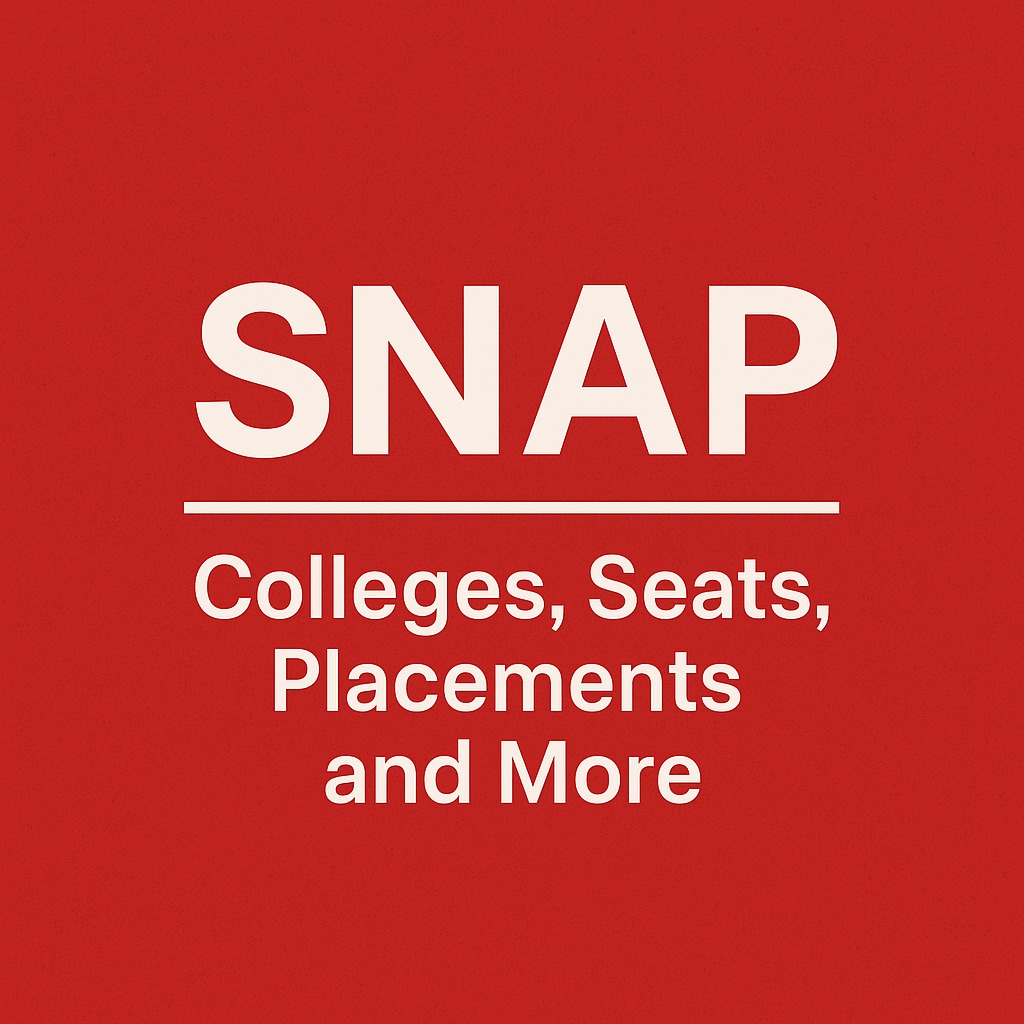
SNAP – Colleges, Seats, Placements and More Symbiosis International (Deemed University) (SIU) offers a unified gateway—SNAP—to 17 constituent institutes across six campuses, each specializing in different facets of management education. Whether your passion lies in core business disciplines, technology, media, sports, healthcare, or agri-operations, a single SNAP score lets you apply to multiple programmes. Below is a comprehensive guide to every SNAP-participating institute: location, affiliation, key PG courses with approved seat-intake, fee structure, indicative living costs, placement highlights and marquee recruiters. The Symbiosis National Aptitude Test (SNAP) is one of India’s premier MBA entrance examinations, serving as the gateway to the prestigious management programmes offered by Symbiosis International (Deemed University) [SIU]. Launched in 2007, SNAP was designed to streamline the admission process for Symbiosis’s diverse portfolio of MBA and specialised postgraduate programmes across its multiple campuses. Over the years, SNAP has built a strong legacy, consistently attracting over 50,000 aspirants annually who vie for seats in 17 renowned institutes covering fields such as business management, information technology, healthcare, international business, and more. Known for its student-friendly format and emphasis on speed, SNAP tests candidates in quantitative ability, logical reasoning, and English skills. With its evolving structure and credibility, SNAP has cemented its place alongside other top B-school entrance exams in India, opening doors to specialised, industry-relevant management education under the Symbiosis banner. Lets have a look Campus wise on key metrices important for aspirants Pune Campus All Pune institutes are constituent colleges of SIU (UGC-recognised; AICTE-approved where applicable). Institute (Acronym) Key MBA Streams & Seats Total Fees (₹, approx.) Avg. Package (LPA) Highest Package (LPA) Top Recruiters Symbiosis Institute of Business Management (SIBM) MBA (General) – 120 ; MBA (Innovation & Entrepreneurship) – 120 12.10 L/yr (Gen MBA) ; 8.60 L/yr (I&E) 28.16 49.00 Accenture, Deloitte, EY, Bain; Amazon, Wipro, Cognizant; HDFC, ICICI, Aditya Birla, Coca-Cola Symbiosis Centre for Management & HR Development (SCMHRD) MBA (General) – 120 ; MBA (Infrastructure) – 60 ; MBA (Business Analytics) – 60 12 L/yr 23.7 32.8 JP Morgan, HSBC, EY Symbiosis Institute of Computer Studies & Research (SICSR) MBA (IT) – 60 ; MBA (Digital Transformation) – 60 11.5 L total 11.0 20.0 Infosys, TCS, Cisco Symbiosis Institute of International Business (SIIB) MBA (Intl. Business) – 30 ; MBA (Agri-Business) – 30 ; MBA (Sustainability) – 30 10 L/yr 13.1 28.7 KPMG, PwC, Godrej Symbiosis Institute of Digital & Telecom Management (SIDTM) MBA (Digital & Telecom) – 60 13.5 L total 12.8 23.0 Vodafone, Reliance Jio, Tech Mahindra Symbiosis Institute of Management Studies (SIMS) MBA (Full-Time) – 240 (incl. Defence quotas) ; MBA (Executive) – 90 4.25 L/yr (FT) ; 3.46 L total (Exec.) 10.2 23.5 ICICI, HDFC, Deloitte Symbiosis Institute of Media & Communication (SIMC) MBA (Communication Mgmt) – 60 10.7 L total 6.0 14.75 Times Group, Zee, Ogilvy Symbiosis Centre for Information Technology (SCIT) MBA (IT Business Mgmt) – 60 ; MBA (Data Science & Analytics) – 60 12 L total 10.5 24.0 Wipro, HCL, Cognizant Symbiosis Institute of Health Sciences (SIHS) MBA (Hospital & Healthcare) – 60 9.4 L total 7.5 14.0 Apollo, Fortis, Max Healthcare Symbiosis School of Banking & Finance (SSBF) MBA (Banking & Finance) – 60 ; MBA (Dual – with Aston/Macquarie) – 60 13.6 L total 8.2 14.75 ICICI, Axis, Kotak Mahindra Symbiosis School of Sports Sciences (SSSS) MBA (Sports Management) – 60 8 L total 5.5 12.0 Sports Authority of India, Adidas, Nike Symbiosis School of Culinary Arts & Nutritional Sciences (SSCANS) MBA (Food Tech & Enterprise Mgmt) – 30 7.5 L total 6.8 10.5 ITC, Jubilant, Tetra Pak Hostel + Mess costs are broadly similar across Pune institutes (₹2.0–2.5 L/yr).Personal expenses (travel, books, leisure): ₹1–2 L/yr.Total annual outlay (fee + living) ranges from ₹15 L for mid-range programmes to ₹28 L for premium streams. Nashik Campus Symbiosis Institute of Operations Management (SIOM) Affiliation: SIU Streams & Seats: MBA (Operations) – 60; MBA (Agri-Operations) – 60 Fees: ₹16 L total Avg. Package: ₹12.4 LPA | Highest: ₹18 LPA Top Recruiters: Hindustan Unilever, ABB, Tata Motors Bengaluru Campus Symbiosis Institute of Business Management, Bengaluru (SIBM–B) Streams & Seats: MBA (General) – 120; MBA (Business Analytics) – 60 Fees: ₹19 L total Avg. Package: ₹13.5 LPA | Highest: ₹26.5 LPA Top Recruiters: Capgemini, Infosys, Amazon Hyderabad Campus Symbiosis Institute of Business Management, Hyderabad (SIBM–H) Seats: MBA (General) – 120 Fees: ₹13 L total Avg. Package: ₹9.5 LPA | Highest: ₹15.5 LPA Top Recruiters: Deloitte, KPMG, Cognizant Nagpur Campus Symbiosis Institute of Business Management, Nagpur (SIBM–N) Seats: MBA (General) – 120; MBA (Food & Agri-Business) – 60 Fees: ₹13 L total Avg. Package: ₹10.8 LPA | Highest: ₹18 LPA Top Recruiters: Nestlé, Parle Agro, ITC Noida Campus Symbiosis Institute of Business Management, Noida (SIBM–Noida) Seats: MBA (General) – 120 Fees: ₹12 L total Avg. Package: ₹11.2 LPA | Highest: ₹20 LPA Top Recruiters: Wipro, HCL, Genpact Why SNAP Verse Matters Unified exam, diverse choices: One SNAP registration opens doors to 17 institutes spanning core management, tech-driven roles, creative media, healthcare administration, sports and culinary entrepreneurship. ROI across tiers: Premium brands like SIBM Pune and SCMHRD command higher fees but deliver average packages of ₹25–28 LPA with marquee recruiters. Niche streams (SIHS, SSBF, SSSS, SSCANS) require lower investment (₹7–10 L) and yield ₹6–8 LPA avg. City-wise living: Pune’s total cost (~₹15–28 L/yr) is benchmark; Nashik, Bengaluru, Hyderabad, Nagpur and Noida show similar or slightly lower living costs. Placement authenticity: Most institutes report 100% placements with 80–100 recruiters; internship stipends at top campuses (like SIBM Pune) average ₹3.2 L/month. Targeted specializations: From Agri-Ops at SIOM to Sports Management at SSSS and Digital Transformation at SICSR, choose a programme aligned to your career vision.
IIM Mumbai – A Baby IIM with a mammoth legacy
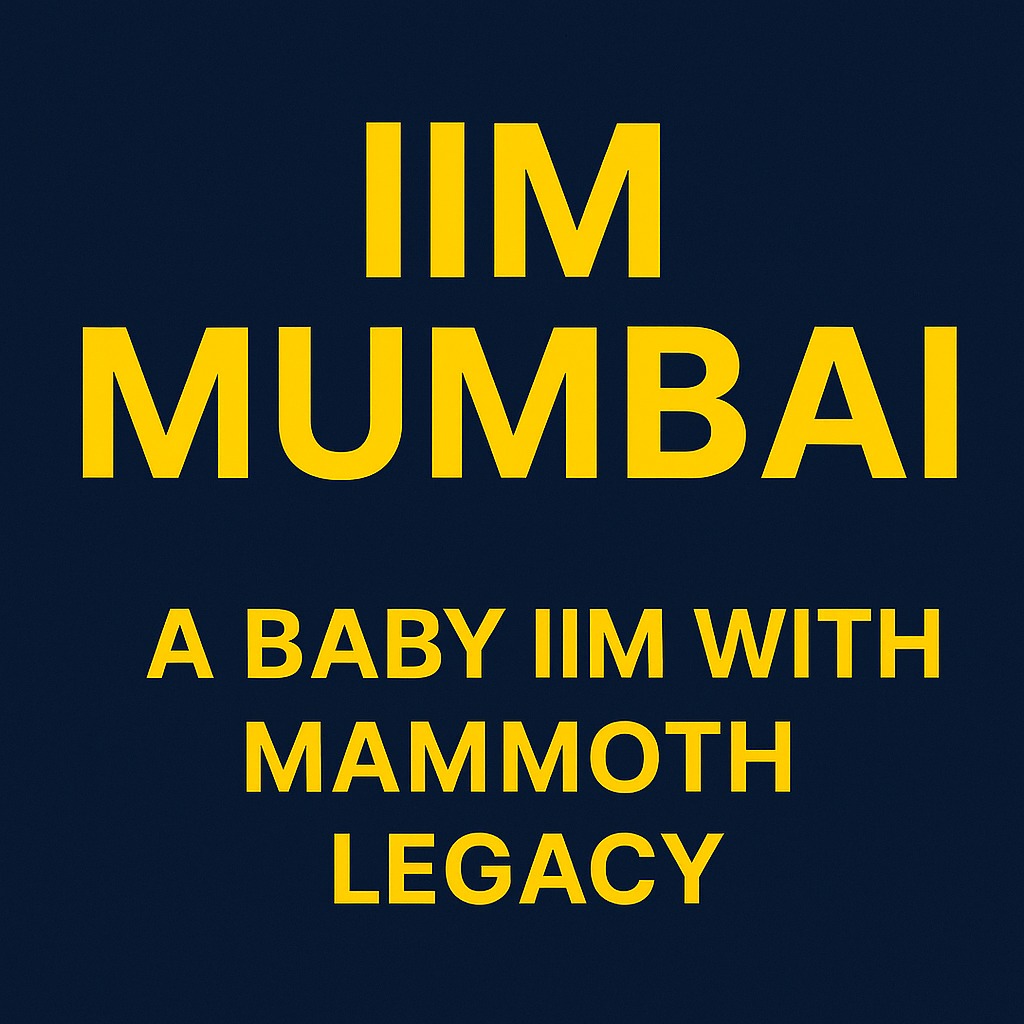
IIM Mumbai – A Baby IIM with a mammoth legacy For over six decades, the National Institute of Industrial Engineering (NITIE), Mumbai, has stood as a beacon of excellence in the fields of industrial management, operations, and supply chain. Established in 1963 under the aegis of the Government of India with assistance from the International Labour Organization (ILO), NITIE carved a niche for itself as one of Asia’s foremost institutes for grooming engineering and management talent to power India’s industrial growth. Often called the “Mecca of Supply Chain & Operations,” NITIE earned immense respect for its rigorous academic programs, industry-oriented curriculum, and consistent track record of producing leaders for top organizations across manufacturing, consulting, IT, and logistics sectors. Over the years, NITIE graduates became synonymous with operational excellence and managerial competence, contributing to India’s economic and industrial transformation. Recognizing its unparalleled contribution to management education and its growing stature, NITIE was granted the prestigious IIM status in August 2023. Now known as the Indian Institute of Management Mumbai (IIM Mumbai), it becomes the 21st IIM in the country and the only IIM located in India’s financial capital. The transition to IIM Mumbai not only preserves NITIE’s rich legacy but also opens new avenues for academic innovation, global collaboration, and cross-domain leadership development. With this elevation, IIM Mumbai aligns itself with the IIM ecosystem’s academic benchmarks while retaining its core strengths in operations, supply chain, sustainability, and emerging domains like technology management. As IIM Mumbai, the institute embarks on an exciting new chapter—offering MBA programs that cater to evolving industry needs while leveraging Mumbai’s strategic location to foster unparalleled industry engagement, research excellence, and leadership development for the next generation of management professionals. Lets look at IIM Mumbai from a test taker perspective and here is all you need to know if you are targeting IIM Mumbai this year. 🏛️ Institutional Upgrade & Degree Transition Originally National Institute of Industrial Engineering (NITIE), established in 1963 as a premier operations & supply‑chain school. Officially conferred IIM status in July 2023 via the IIM Amendment Act – becoming the 21st IIM, now IIM Mumbai Programs have been restructured into an MBA, along with MBA in Operations & Supply Chain Management (OSM) and Sustainability Management, aligning with IIM academic structures. 🧭 Latest Admission Criteria (PGP 2025–27) Entrance: Selection via CAT, with high sectional cutoffs—especially QA ≥ 92–94+, DILR & VARC ≥ 88–92+. CAT Percentile: Expect 98+ overall for general category; actual cutoffs are competitive due to IIM tag. Profile Considerations: Work experience and academic background are weighed in the selection process—shift from engineer-only to full-spectrum backgrounds broadens appeal. Diversity: Non-engineers now admitted; diversity being factored for merit & final selection. 📚 Batch Profile: PGP 2022–24 & 2023–25 According to official and third-party sources: 2022–24 (Converted mid-course): Batch Size: 446 students (373 male, 73 female). Experience: Mix of freshers and professionals from IITs, NITs, BITS; ~170 PPOs. 2023–25: Likely larger and more diverse batch with non-engineers included. Reddit and other channels indicate optimism about broader representation. 🏅 Placement Highlights: Class of 2024–25 Final Placements 2025: 100% placement achieved—198 companies participated Salary Ranges: Top 10%: ₹47.5 LPA (avg) Top 20%: ₹41.2 LPA Top 50%: ₹34.1 LPA Overall average: ~₹29.8 LPA (up ~5%) Median: ~₹27 LPA; PPO average: ₹29.4 LPA. Highest packages reported: ₹47.5 LPA and ₹54 LPA (Microsoft offer). Sector Breakdown: Manufacturing/Operations: 19% – core strength. Consulting: ~17–18% – top firms hiring. BFSI: 16% – strong financial recruitments. Tech/Product & E-commerce: 14% – includes Amazon, Flipkart. Pharma & Healthcare: 130% increase in placements YoY, driven by sector demand. Top Recruiters: Accenture (41 offers, avg ₹45.37 LPA), PwC India (18), PwC US Advisory (10), Alvarez & Marsal, Praxis, Vodafone Idea, Workday, ZS, MS Internships 2024–26: Summer internship 2024: 480 offers to 425 students; PPOs = 170 (~73% conversion) Internships strong in manufacturing, FMCG, consulting, BFSI, and e‑commerce 🧭 Why IIM Mumbai is a rising star in Indian B-School Space Legacy Strength + IIM Brand: IIM Mumbai blends NITIE’s industrial domain expertise with pan-domain MBA appeal. Competitive Entry: High CAT cutoffs and sectional benchmarks, particularly in QA, reflect increased competition. Robust Placement Ecosystem: Diverse high-paying roles with top-tier recruiters across sectors. Core Discipline Edge: Manufacturing & operations roles remain strong; consulting & tech expanding. Rising ROI: Enhanced reputation post-conversion likely boosts fees but placements keep pace (~+5% avg salary).
🗣️ CAT 2024 Quantitative Section Analysis: Slot-Wise Breakdown & Lessons for CAT 2025
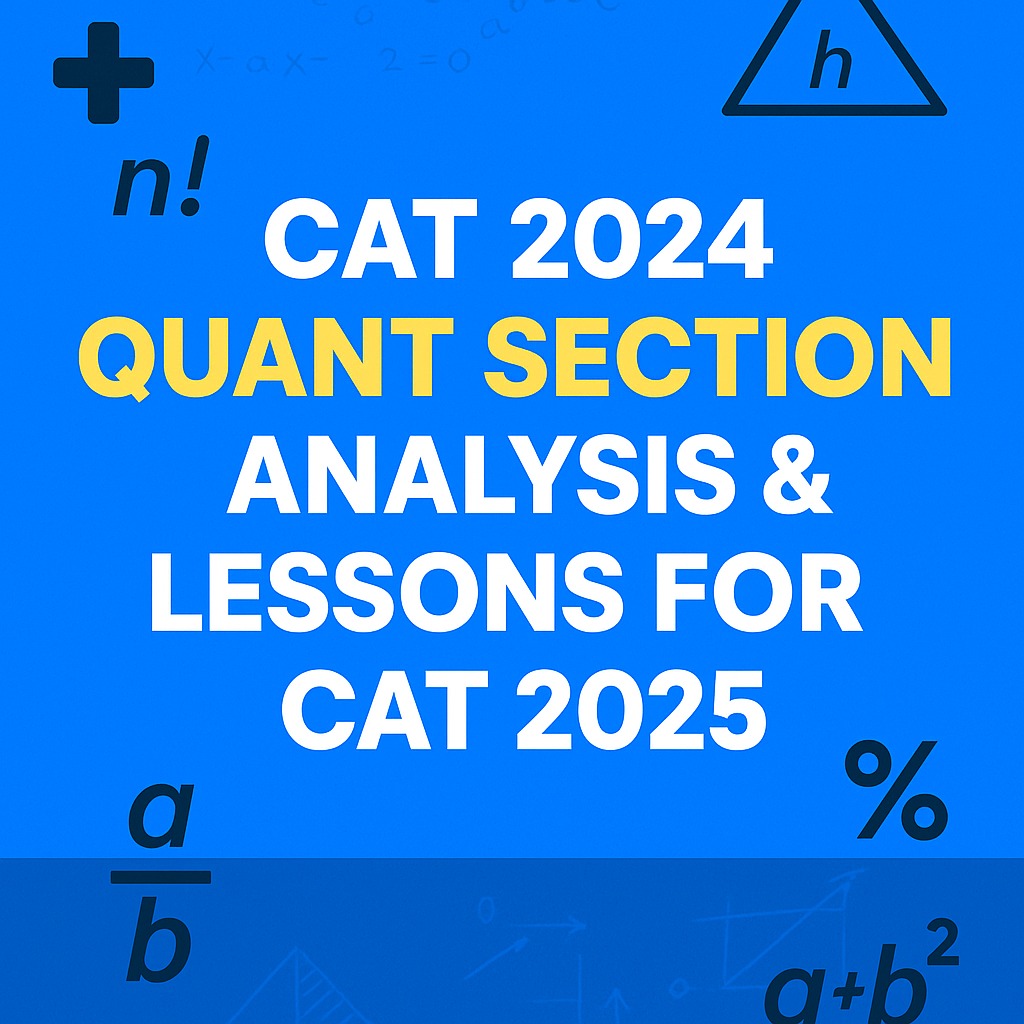
Total Questions: 22Format: All questions were MCQs, no TITA (Type in the Answer) questions reported.Topics Covered: Arithmetic-heavy, followed by Algebra, Numbers, Geometry, and Modern Math.Level of Difficulty: Slot 1: Moderate Slot 2: Moderate-Difficult Slot 3: Easy-ModerateTrend continued from CAT 2023: conceptually simple, but calculation-intensive and selection-based. 🎯 SLOT-WISE QUANT ANALYSIS 📌 CAT 2024 – Slot 1: Moderate ✅ Topic-Wise Distribution (Approx.) Arithmetic: 8–9 Qs Algebra: 5–6 Qs Numbers: 2–3 Qs Geometry & Mensuration: 2 Qs Modern Math (Logs, Functions, P&C): 1–2 Qs 🔍 Key Observations Arithmetic questions were standard, but required careful reading. Algebra had questions from quadratic identities, modulus, and inequalities. Numbers included base systems and divisibility. Geometry was limited, but both questions had diagrams. A couple of questions had traps—language ambiguity. 🧩 Notable Questions A question on mixture and ratio with three containers. A tricky modulus-based inequality. A time-speed-distance problem involving trains crossing a platform. 🧠 Ideal Attempts: 14–16 🎯 Good Score: 36–40 📌 CAT 2024 – Slot 2: Moderate to Difficult ✅ Topic-Wise Distribution (Approx.) Arithmetic: 7 Qs Algebra: 6–7 Qs Geometry & Mensuration: 2–3 Qs Numbers: 3 Qs Modern Math: 1–2 Qs 🔍 Key Observations Questions were conceptually twisted even if the topic was standard. Some algebra problems needed 2–3 substitutions before clarity emerged. Time and work, pipes and cisterns problems were heavily calculation-driven. Several questions were non-formula-based, required logical reasoning. 🧩 Notable Questions Cyclic quadrilateral with radius and area implications. Work Efficiency problem involving 4 people with changing speeds. A clever logarithmic identity question. 🧠 Ideal Attempts: 12–14 🎯 Good Score: 32–36 📌 CAT 2024 – Slot 3: Easy to Moderate ✅ Topic-Wise Distribution (Approx.) Arithmetic: 9 Qs Algebra: 5 Qs Numbers: 3 Qs Geometry: 2 Qs Modern Math: 2–3 Qs 🔍 Key Observations Highest number of doable questions compared to other slots. Arithmetic was dominant and very straightforward—profit-loss, time-speed-distance, averages. Algebra focused on basic identities and equations. Geometry included triangle and circle properties, but with clean data. Many students reported finishing 18–20 questions with confidence. 🧩 Notable Questions Partnership-based question with simple logic. Progression question (AP) involving sum and term value. An easy function-based problem involving modulus. 🧠 Ideal Attempts: 16–18 🎯 Good Score: 42–48 📈 Comparative Summary Table Parameter Slot 1 Slot 2 Slot 3 Difficulty Level Moderate Moderate–Difficult Easy–Moderate Arithmetic Focus High Moderate Very High Algebra Focus Medium High Medium Geometry & Numbers Low–Medium Medium Low–Medium Modern Math Low Low Low–Medium Good Attempts 14–16 12–14 16–18 Good Score (Raw) 36–40 32–36 42–48 🔎 Key Takeaways for CAT 2025 Aspirants Arithmetic is the King – It has consistently made up 35–45% of QA in all recent CATs. Practice Selection – Choose which 14–16 questions to attempt in 40 minutes. Deepen Algebra – Emphasis on modulus, quadratic inequalities, and functions. Numbers – Focus on divisibility, base systems, and remainders. Smart Practice – Simulate CAT difficulty and decision-making in mocks. 📘 Topic-Wise CAT 2024 Quant Question Bank (Based on Memory) Arithmetic (8–9 Qs per slot) Profit-Loss: % gain/loss, marked price, successive discounts Time-Speed-Distance: Trains, relative speed, circular tracks Time & Work: Efficiency, men-women days, pipes & cisterns Averages, Mixtures & Alligation: Three container mix, weighted averages Ratio-Proportion: Partnership, direct/inverse variation Simple/Compound Interest: Basic applications Percentages: Discounts, change comparisons Algebra (5–7 Qs per slot) Quadratic Equations: Roots, nature, factorization Modulus Inequalities: |x–a| = b; conditions Linear Equations: Two variable setups Algebraic Identities: a² + b² + 2ab forms Functions & Graphs: Domain, modulus, piecewise Surds & Indices: Comparisons, simplifications Numbers (2–3 Qs per slot) Divisibility: LCM/HCF, remainders Base Systems: Binary/decimal conversion Number Properties: Digits, even/odd, unit digits Geometry & Mensuration (1–3 Qs per slot) Triangles: Similarity, right-angle, medians Circles: Radius, chords, cyclic quadrilateral Quadrilaterals: Areas and diagonals Mensuration: Cuboids/cylinders basic formulae Modern Math (1–2 Qs per slot) Logarithms: log identities, base conversions Progressions: AP/GP nth term and sum Permutations & Combinations: Seating/basic cases 🧭 Chapter-wise CAT 2025 Quant Prep Plan (July–November) 🔹 JULY: Foundation Building Arithmetic Basics: Percentages, Ratios, Averages Numbers: Divisibility, Factors, HCF/LCM Algebra Intro: Linear equations, identities Geometry Basics: Lines, angles, triangle properties✅ Daily: 10 QA Questions (Beginner), 2 Mocks/Week 🔹 AUGUST: Core Skill Development TSD & Work: Solve 30+ mixed questions Quadratics, Modulus, Inequalities Mensuration: Area & Volume formulas Logs & Progressions✅ Weekly Topic Test + 2 Mocks + Error log 🔹 SEPTEMBER: Moderate to Advanced Problems Functions, Graphs, Surds, Base systems Circles & Triangles Advanced Arithmetic Mixed Sets under time DI with Quant: Apply %/Ratios in DI✅ 3 Full Mocks/week + Past CAT QA Practice 🔹 OCTOBER: Final Strengthening Focused Practice on Weak Areas Mixed Topic Tests – 40-minute blocks Timed Sets – 22 questions in 40 mins CAT-style Questions from 2023–24 papers✅ 4 Mocks/week with video/peer analysis 🔹 NOVEMBER: Final Push Revise key formulas & concepts Mocks every alternate day 3-hour full CAT simulations Use Endeavor Magic Tolkit Solve last 10 years QA questions (slot-wise) For more information or to buy magic toolkit product contact or click
NMAT 2024 Overview and Lessons for NMAT 2025
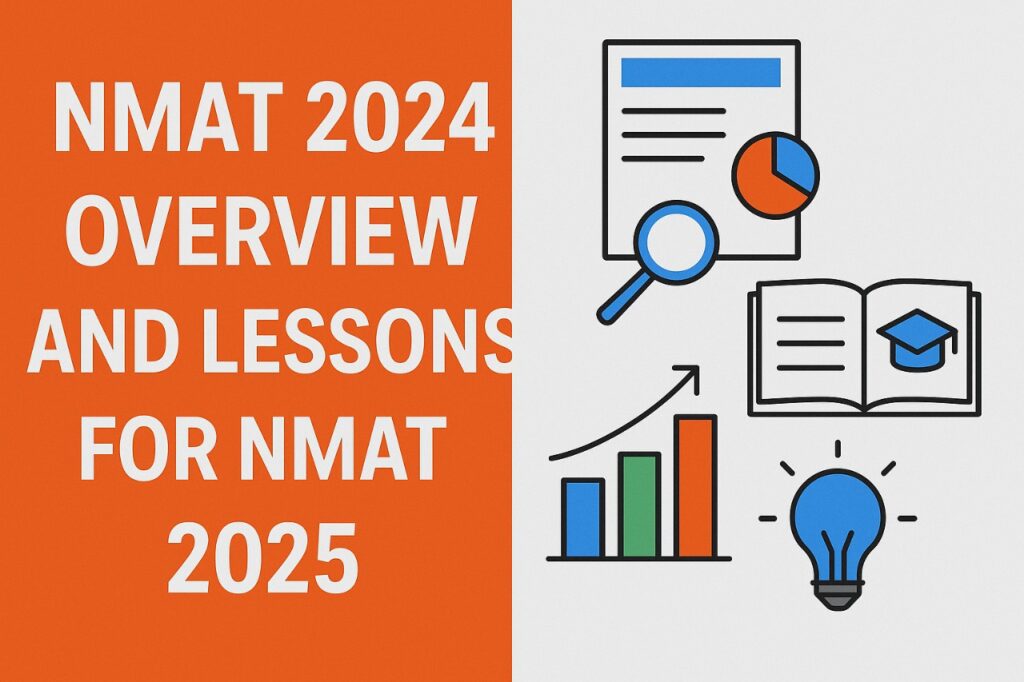
Importance of NMAT for MBA Aspirants in India The NMAT by GMAC has become a key MBA entrance exam in India. Its scores are accepted by over 50 MBA programs in India (and dozens abroad), including top schools such as SVKM’s NMIMS (various campuses), XIM University (Bhubaneswar), K J Somaiya, TAPMI, Great Lakes, SPJIMR, IFMR GSB, VIT Vellore, SDA Bocconi Asia, and others. It is often described as “candidate-friendly”: for example, test-takers enjoy flexible scheduling and up to three attempts per testing cycle. The exam is computer-adaptive (like the GMAT) with no negative marking, and candidates receive their unofficial score immediately after each attempt. Each year roughly 75,000+ aspirants take NMAT aiming for admission to ~78 participating B-schools. These features – wide acceptance by quality programs and a flexible format – make NMAT an important pathway to MBA admission in India. Top B-schools use NMAT: NMAT scores are accepted by leading MBA programs (NMIMS Mumbai/Bangalore/Hyderabad, XIMB, KJ Somaiya, etc.). Candidate-friendly format: Computer-based, no penalty for wrong answers, adaptive difficulty, instant scoring, and multiple attempts. High participation: Annually ~75,000 candidates take NMAT for admission to 78+ institutions. NMAT 2024 Exam Pattern and Structure NMAT by GMAC is a computer-based adaptive test with three sections. Each section has 36 multiple-choice questions and is independently timed. The structure for 2024 was (as per GMAC/official pattern): Section No. of Questions Time (minutes) Score Range Language Skills 36 28 12–120 Quantitative Skills 36 52 12–120 Logical Reasoning 36 40 12–120 Total 108 120 36–360 Sections: Language Skills, Quantitative Skills, Logical Reasoning. Each has equal weight (36 Q). Timing: Total time = 120 minutes. Time per section is fixed (28 min for Language, 52 min Quant, 40 min Reasoning). Candidates must attempt each section in order (they may choose section order at start) and cannot return to a completed section. Scoring: Each question carries +3 marks; no negative marking. Raw scores are scaled: each section score is reported on a 12–120 scale (so total score 36–360). For example, a perfect raw score would scale to 120 in each section. Adaptive format: The exam adapts to ability – as you answer correctly, questions become harder – similar to GMAT. This ensures a consistent scoring scale. Section-wise Difficulty and Score Analysis (NMAT 2024) In 2024 the NMAT was generally rated easy-to-moderate in overall difficulty. Section-by-section observations (per post-exam analyses) were: Language Skills (36 Q, 28 min): Easiest section. Typically included 3 RC passages (12 Q) plus questions on para jumbles, analogies, error-detection, prepositions, sentence completion, etc. Most candidates found it “easy-to-moderate” in difficulty. Strong performance here greatly benefits the overall score. Logical Reasoning (36 Q, 40 min): Moderate difficulty. Included analytical puzzles (arrangement, seating, etc.), input-output sequences, and critical reasoning questions. The section emphasized critical reasoning and deductions (with some new puzzle types), and was generally tougher than Language but easier than Quant. Quantitative Skills (36 Q, 52 min): Most challenging section. Topics included arithmetic, algebra, number systems, probability, permutations & combinations (PNC), logs, sequences (AP/GP), and data interpretation. In 2024, there was an increased focus on divisibility, PNC, logs, etc. Overall, this section ranged from moderate to tough, with some questions considered time-consuming or tricky. Each section is scored out of 120. For context, a total NMAT score in the 230–250 range is typically excellent and reflects ~99th percentile performance. In 2024, a score of ~240+ was often considered outstanding (especially for top-tier colleges), whereas around 200–220 would be competitive for many good B-schools. (Note: NMAT no longer reports percentiles per score; selection is based on raw scores.) Some B-schools enforce sectional cutoffs as well; for example, in 2024 NMIMS Bangalore reportedly required ~74 in Quant, 73 in Reasoning, 75 in Language to shortlist. NMAT Scores and B-School Shortlists (Cutoffs) Different B-schools set their own NMAT cutoff scores for interview calls. The following table summarizes approximate NMAT 2024 cutoffs for prominent programs (total score out of 360) based on official announcements and expert estimates: B-School (Program) NMAT 2024 Cutoff (Score Range) NMIMS, Mumbai (MBA Core) ~225–235+ (209 for application) NMIMS, Bangalore (MBA) ~220+ NMIMS, Hyderabad (MBA) ~200+ NMIMS, Navi Mumbai (MBA) ~210+ Xavier University (XIMB, Bhubaneswar) ~200–210 K J Somaiya Institute, Mumbai ~220–225 SDA Bocconi Asia Centre, Mumbai ~190–200 T.A. Pai Management Institute (TAPMI) ~220 Notes: These are indicative ranges. NMIMS Mumbai historically had the highest cutoffs (~230+ NMIMS Bangalore and Hyderabad have slightly lower cutoffs (~220 and ~200 respectively). XIM University Bhubaneswar (XIMB) typically looks at scores around 200+. Each school may also consider sectional cutoffs and other factors, so candidates should check specific program requirements. (For comparison, Great Lakes PGPM (~190–200) and SPJIMR GMP/PGDMW (~170–190) also use NMAT, but are outside the above list.) Exam Administration and Policies NMAT is administered by GMAC over an extended window each year. For NMAT 2024, the exam window ran roughly from November 5 to December 20, 2024. Candidates could register beforehand and then schedule their preferred test date within this window. Mode: Test-takers in India can choose between taking the exam at an official test center or via online proctored (home) mode. GMAC operates 70+ test centers across India. (Outside India, only the online mode is available.) The online mode is proctored, requiring identity verification and continuous monitoring. Attempts/Retakes: Each candidate is allowed up to 3 attempts in the testing window (initial test + 2 retakes). There must be at least a 15-day gap between attempts. This flexibility lets aspirants improve their score if needed. (Caution: Some institutes – e.g. NMIMS – accept only the first-attempt score for admission, so applicants targeting those schools should plan accordingly.) Results: After completing an attempt, the candidate sees an unofficial score immediately. The official NMAT scorecard (with sectional and total scores) is released within 48 hours. Scores from all attempts are available, and candidates has to choose which attempt’s score to send to schools. Other details: The NMAT registration fee (2024) was ₹2,300 (late fee ₹2,800). Test-takers may reschedule (with a fee) up to 72 hours before an exam slot.
